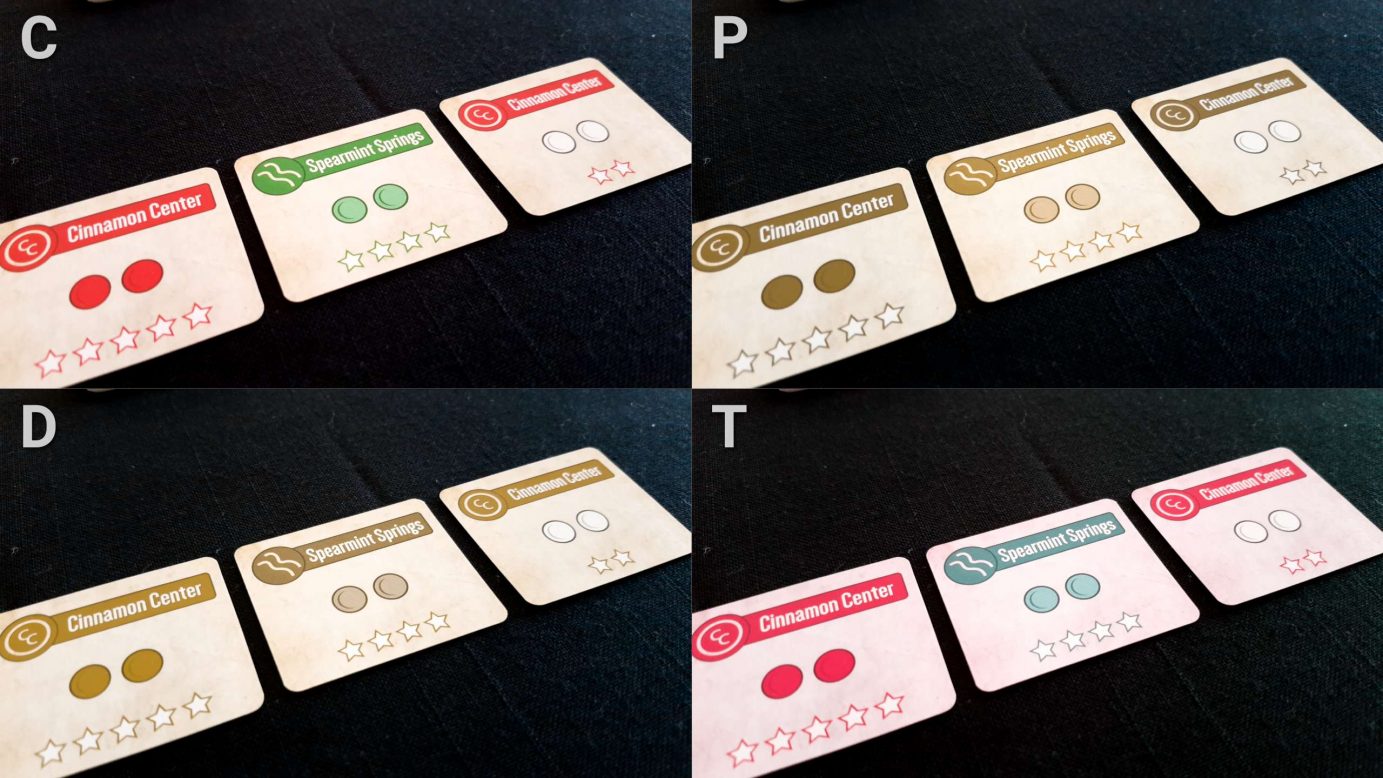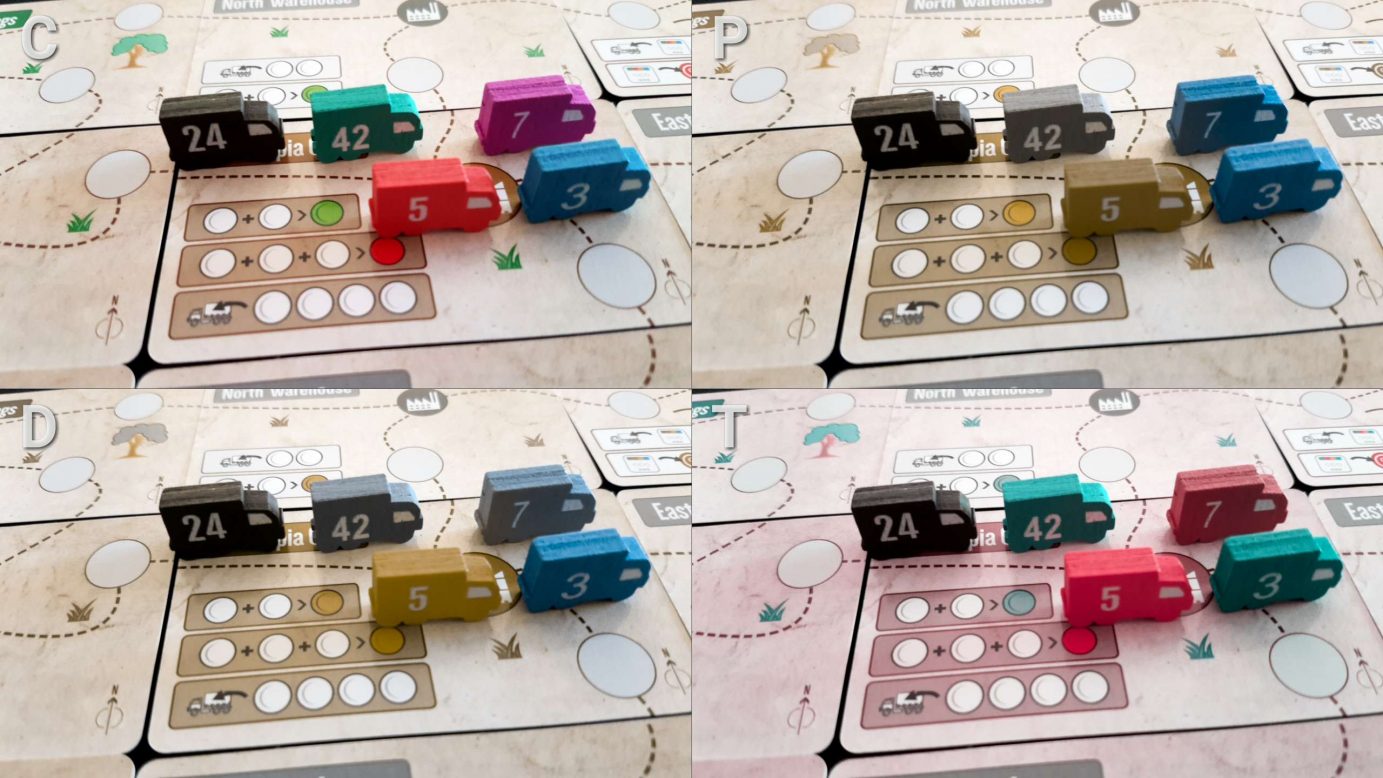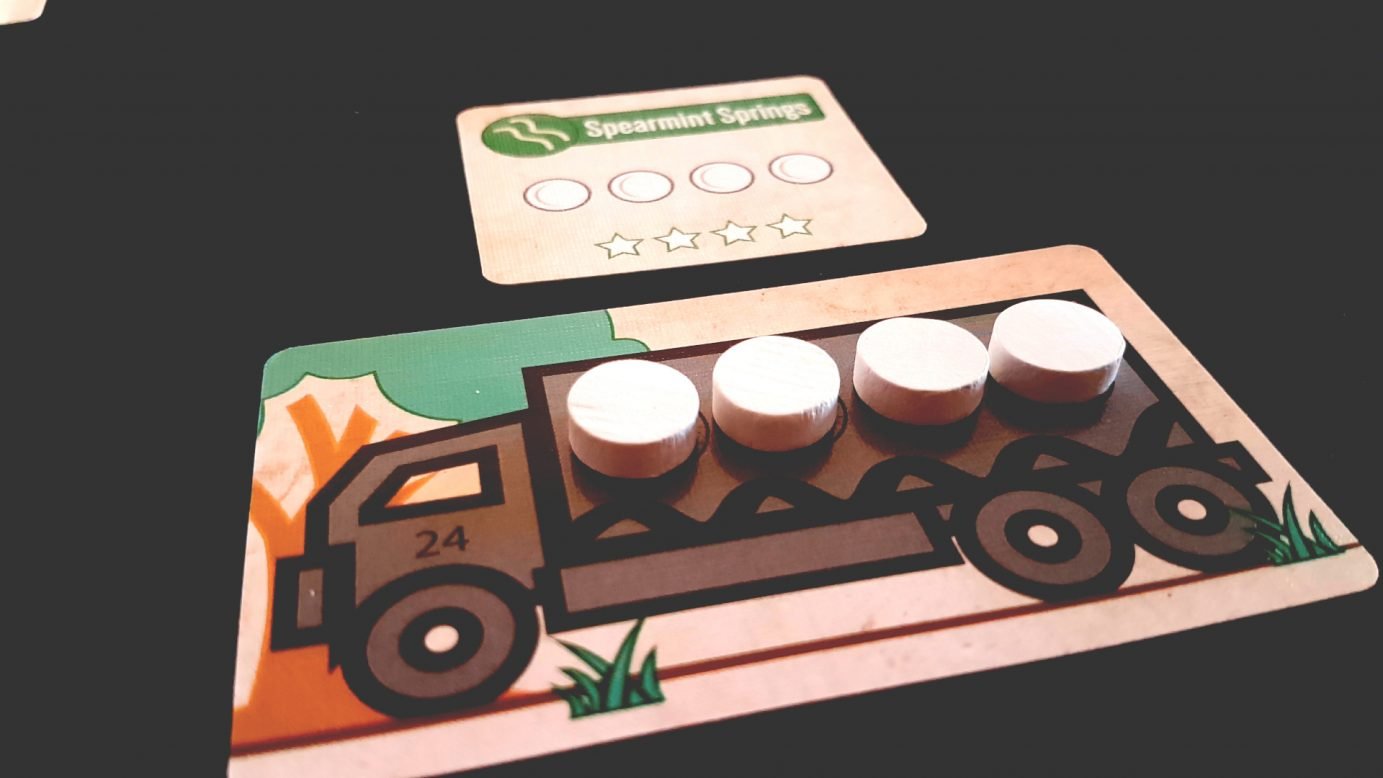Table of Contents
| Game Details | |
|---|---|
| Name | Mint Delivery (2017) |
| Accessibility Report | Meeple Like Us |
| Complexity | Medium Light [1.55] |
| BGG Rank | 3928 [6.19] |
| Player Count (recommended) | 1-5 (2-5) |
| Designer(s) | Justin Blaske |
| Buy it! | Amazon Link |
Version Reviewed
Introduction
We didn’t have much positive to say about Mint Delivery, which at least means our view is consistent since we also didn’t have much positive to say about Mint Works. ‘They are games that function’. ‘Full components in the tin’. Neither of those are blurbs likely to appear gracing the back of either game in the future. We gave Mint Delivery two stars in our review, but really it’s most interesting as an example of the importance of refinement and the counter-intuitive lesson that balance isn’t always the best thing to strive for in a play experience.
Enough of that though. Mint Works, the previous game in this series, did poorly in its review and rather well in its teardown. Let’s see whether Mint Delivery turns a single data point into a trend. Games get two chances to shine on Meeple Like Us, and maybe we can have good things to say here. I hope so! I don’t enjoy being the grumpy curmudgeon even though it’s so perfectly fitted into my natural personality and inclination.
Let’s see what’s in the back of the truck.
Colour Blindness
The mints that players work with are… fine. The use of red and green is a bit of a blunder but except in circumstances of extreme colour blindness along with poor lighting conditions they are generally possible to make out. They only represent a kind of currency marker though so they can be replaced with something else (money for example) if needed.

The specific hue of colour chosen is also mostly fine on the cards, although it would, as usual, have been much better if this information had been double coded as well as making use of a more clearly defined palette. It’s unlikely to be a persistent problem in the game.

The delivery locations are a little more problematic for their colour palettes, but in the end it doesn’t matter because they have specific written place-names that unambigiously reference them.

The trucks that you drive make use of colour to identify them but also come with a unique number that solves the problems this would otherwise cause.

We’ll recommend Mint Delivery in this category.
Visual Accessibility
The visual design of Mint Delivery is very clean and well structured. Players get tactile indicators of the location of trucks (but not their owners), and the number of mints in their truck (but not their colours). However, with a 3×3 board there’s not much you need to track and inquiring of other players rarely has any real impact because functionally there’s nothing you can do with information you get about other player intentions.

Contracts are played open, which resolves a visual accessibility issue that might otherwise exist, so really all a player will ever need to ask on their turn is ‘Where am I’, ‘What colour are my mints’, and ‘What are my contracts’. Every warehouse offers the same loading opportunities and the same conversion options, and they’re always located in the same place every game.

The only other area of concern is that each of the four corner locations will have a pair of contracts available and this means that there may be as many as eight, some with mints on them, to consider. However, the dynamic of the game almost always breaks down to ‘Go to where I have a contract I can complete’ and then ‘Pick up a contract there’. As such, in real terms you’re only ever considering between two contracts at most because there’s rarely a good reason to drive to a location where you don’t have a delivery. No matter what contracts it has available.

Player powers complicate things if they are introduced, as do the road markers that change the nature of the routes. There are only ever three powers in play in the game at a time though, and their use is optional. The game becomes considerably more difficult to visually parse if the route tokens are used, but their use is also optional. The problem with that though is that there just isn’t much game in Mint Delivery at the best of times and using either of these variations is almost mandatory to give yourself something to do.

We’ll nonetheless recommend Mint Delivery in this category, because the base game itself is accessible.
Cognitive Accessibility
The game has only a few decisions you need to make turn to turn and they can be easily handled through simple heuristics. There’s not a lot of benefit that comes from puzzling out the optimisation of your turns, although there is a little. If you have two contracts, one for delivering two tokens and one for delivering four, it has an implication. You wouldn’t want to deliver two and then load up at Mintopia since you’d lose the two excess you’d otherwise get. Similarly for conversion of mints. But really in most cases you don’t need to think much about it and the implied numeracy is not high. Contracts do have different values but they represent this with star symbols and a straight up comparison of ‘more or less’ can be used instead of arithmetic.
There’s some benefit that comes from knowing deck composition as far as the contracts go, but not enough that it’s a big deal. You’re never going to be biding your time for just the right contract to appear. You’ll always just be working with what’s there except perhaps in the end-game scenario where there’s more chance you’ll see something you expect at a time you might be able to exploit it. It’s a very minor issue. Slightly more problematic is that you get two actions per turn and some things you can do in the game (make a delivery as the obvious one) don’t actually use up one of those actions. Keeping track of how many things you and your opponents can actually do creates a memory burden that would either need to be kept in mind or compensated through the use of some kind of external tracker.
The game has no need for literacy, no real need for tactical or strategic thinking on an advanced level, and has reasonably simple rules that lower the cognitive ceiling for play. Variants increase the complexity of the game, but they can be used or not as is appropriate and this remains one of my favourite cognitive accessibility features. Bolt-in rules are wonderful to see as an element in this category of our teardowns.
We’ll recommend Mint Delivery in both of our categories of cognitive accessibility, provided the base expectation of understanding the rules is not unreasonable.
Physical Accessibility
The board that you use in the game is made up of a 3×3 grid of cards and this requires a fair degree of precision to put together neatly. However, it also has no real impact on the game if you don’t put them together neatly. The routes between locations are predictable and don’t need the visual cue of their representation on the cards. If using the variants involving player powers and/or road tokens then layout of those elements becomes more problematic. They aren’t given generous proportions and their physical position has game meaning. Not so much that you couldn’t fudge it though.
The truck card you have to hold your tokens has very small segments into which the mints fit, but it’s not actually at all necessary to use it. You have four mints you can hold at a time, and that’s all that’s needed.
Moving trucks around the map doesn’t require any particular person to do it, and all instructions can be fully verbalised. ‘Move my truck north and then east, then deliver three white mints’.
We strongly recommend Mint Delivery in this category. While its proportions are not generous for many of its tokens, it’s also not a game that is overly fussy in having them used. You can easily get by with a looser arrangement.
Emotional Accessibility
The only competition in the game is over contracts, and honestly that isn’t much of a reason to get upset. You’re never blocked from accomplishing something, and even when players buy the special power cards you also get to buy them yourself if you like. The only thing that might potentially cause upset is if a player ends up not being able to claim a contract from a location to which they are traveling. This might occasionally happen towards the end-game but it’s pretty much the only point of contention in an otherwise symmetrical game.
We’ll strongly recommend Mint Delivery in this category.
Socioeconomic Accessibility
There are no human characters in the game. The manual makes use of the second person perspective and does not default to masculinity.

I got my copy of Mint Delivery via a double Kickstarter reward with Mint Works, but you can pick it up for about £10 on Amazon and $15 on the Five24 Labs website (although with a delivery cost that might well be eye-watering). Certainly if you can pick it up locally the price won’t likely be something to worry about. The game plays up to five players, and works as well as it ever works at all player counts from two to five according to BGG. There’s also a solo mode in the game but I’ll admit I never actually played it and the BGG consensus is that I was right to give it a swerve.
We’ll strongly recommend Mint Delivery in this category if you can get it locally.
Communication
There’s no need for literacy during the game and no formal need for communication between players.
We’ll strongly recommend Mint Delivery in this category.
Intersectional Accessibility
Often in these sections I say ‘It’s such a bad performance that any intersection is automatically likely to be a problem’, and here I can say almost the opposite. The only thing I will say is that in the event a player is colour blind and visually impaired there is reason to be cautious. Even in that circumstance I suspect it would be possible to work around it with verbal instructions and support from the table. Really Mint Delivery has done so well that this section will be very short.
The game plays very quickly, taking perhaps twenty minutes at two players and maybe thirty or forty at a full player count. If players want to drop out the effect on the game itself is minimal, but the game itself is low enough intensity that it’s unlikely to exacerbate issues of discomfort or distress.
Conclusion
I really don’t like writing negative reviews. They always feel mean-spirited even if I try my hardest to illuminate the reasons behind my opinion as well as the opinion itself. I think a critical review is valuable because it means people know, based on the argument, whether it will work for them. That doesn’t mean I’m indifferent to the emotional cost to a designer that makes the mistake of reading reviews of their work. I avoid Reddit threads where this site is discussed because I can only dish it out. I can’t take it. So it’s great when I can pivot wildly from ‘a negative review’ to ‘an enthusiastically positive teardown’. So it is with Mint Delivery.
| Category | Grade |
|---|---|
| Colour Blindness | B |
| Visual Accessibility | B |
| Fluid Intelligence | B |
| Memory | B- |
| Physical Accessibility | A |
| Emotional Accessibility | A- |
| Socioeconomic Accessibility | A- |
| Communication | A |
Sometimes the reason a game does well in these teardowns is as a result of the very things I was so hard on in the review. That’s why we do the site the way we do – the quality, as I see it, of a game should be assessed in isolation from its accessibility. My goal is to find all the great, accessible, games out there. Those combos are the things that keep me going in the project. If a game excels in one or the other post, well – it’s a decent second prize.
While I only liked Mint Delivery enough to give it a couple of stars, it’s a pickup and deliver game that, accessibility wise, almost everyone can pick up and expect it to deliver.
A Disclaimer About Teardowns
Meeple Like Us is engaged in mapping out the accessibility landscape of tabletop games. Teardowns like this are data points. Games are not necessarily bad if they are scored poorly in any given section. They are not necessarily good if they score highly. The rating of a game in terms of its accessibility is not an indication as to its quality as a recreational product. These teardowns though however allow those with physical, cognitive and visual accessibility impairments to make an informed decision as to their ability to play.
Not all sections of this document will be relevant to every person. We consider matters of diversity, representation and inclusion to be important accessibility issues. If this offends you, then this will not be the blog for you. We will not debate with anyone whether these issues are worthy of discussion. You can check out our common response to common objections.
Teardowns are provided under a CC-BY 4.0 license. However, recommendation grades in teardowns are usually subjective and based primarily on heuristic analysis rather than embodied experience. No guarantee is made as to their correctness. Bear that in mind if adopting them.
